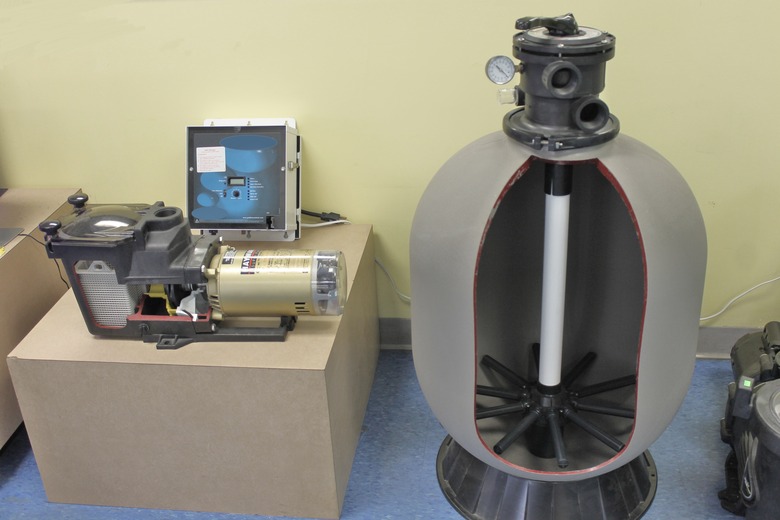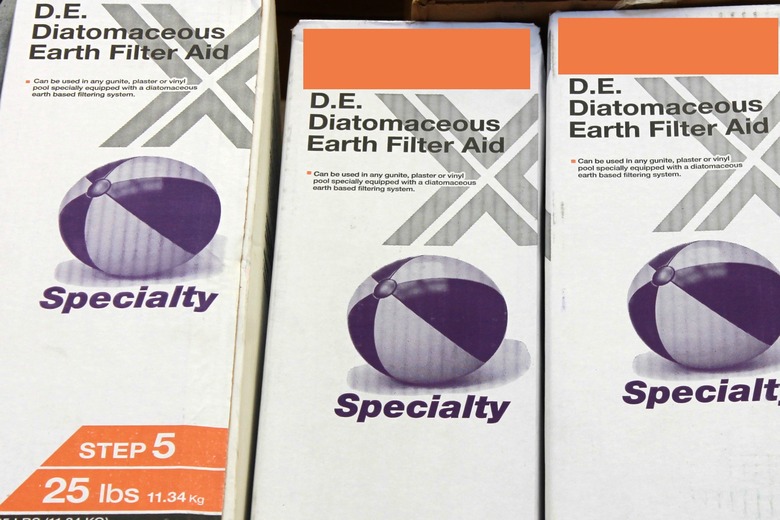Hayward Pool Filters Troubleshooting
Hayward produces a wide variety of pool products, including three types of pump-operated filters: diatomaceous earth (DE) filters, sand filters and cartridge filters. Each has a different method of filtering out contaminants from pool water. These filter types are not unique to Hayward, and like similar filter devices from other manufacturers, Hayward filters can have various minor problems that are usually fairly easy to solve.
DE Filters
DE Filters
Diatomaceous earth filters, normally called DE, operate by pumping pool water through a layer of ground-up particles of sedimentary rock derived from living organisms, called diatoms. Essentially, this is a very fine particulate sand that originated as silica remains of microscopic sea life. As water is pumped through the DE layer, it traps most of the particle contaminants.
DE filters are regarded as some of the best, since the fine particles do a great job of trapping nearly all contaminants, and the pump and filter units are fairly compact. Hayward offers two lines of DE filters, known as Perflex and Progrid. Both lines come in several sizes.
Common symptoms seen with DE pool filters include:
Leaking Around the Bump Shaft
A Hayward Perflex DE filter has a part known as a bump shaft that allows you to manually shake off the DE particles from the parts inside. It is often found on filters that do not have a backwash feature. If you find that water is leaking up around this shaft, then it is likely that the rubber/neoprene O-rings on the shaft are worn or broken and must be replaced.
Bump Handle Is Loose
If you press the bump handle up and down and it still feels loose, then one of the C-rings connected to the shaft is broken or damaged. Both need replacement.
Leaking Backwash Valve
A backwash valve that leaks after you shut it off needs to be replaced. As an interim measure until you can replace the valve, a plug with an O-ring can be screwed into the end of the backwash line. This will allow you to continue to run the filter, though you won't be able to use the backwash function.
Diatomaceous Earth Backs Up Into the Pool
When fine particles of DE powder begin to wash back into the pool, then it means that the filter grids, filter fingers, filter manifold or multiport section of your filter may have a crack or rip. If no damage is found, check the tube sheets through which the filter fingers slide. Cracked ones should be replaced.
Filtering Does Not Occur Even Though the Multiport is Operating
When the filter seems to be operating but no filtering occurs, it means that the spider gasket inside the multiport may be damaged or worn and in need of replacement. If the filter gauge shows high pressure but the filter does not run, then the filter most likely needs a new gauge.
Backwash Line Is Running Water When Multiport Is Set to Filter
If water is running through the backwash line, even thought the multiport control is set to filter, check the gasket for wear or damage.
Sand Filters
Sand Filters
Sand filters operate much the same way as DE filters — they force pool water through a thick layer of sand that removes contaminant particles. Some of the problems with sand filters are similar to those with DE filters, while others are unique to this type.
High Pressure Persists Even After Backwashing
A high pressure reading on the gauge is usually an indication that the sand is fully impregnated with debris and that the system needs to be backwashed to cleanse it. But if this does not reduce the pressure, there might be several reasons:
- If there are too many impurities in the sand , it may clog the system, which means that the sand needs to be changed. Before doing that, though, remove about 1 inch of sand off the top, and replace it with new sand.
- Cleaning the filter system with a specialized filter system cleaner can help too.
An improperly closed or partially closed valve can cause problems, as can a pump and filter that don't work well together. If the pump doesn't deliver at least 60 percent of the filter's flow rate, it will never work properly.
The Filter Is Short-Cycling
To troubleshoot a filter that is short-cycling — building up pressure again very quickly after backwashing — check the user's manual to see if the backwashing period is long enough. Other likely causes include:
- Live algae clogging a filter may lead to problems.
- The sand bed may have mineral deposits and need replacement.
Filter Sand at the Bottom of Your Pool
If you see sand at the bottom of your pool, it could mean the sand is too small. No. 20 silica sand, .45 to .55 mm size, is required in a Hayward filter. Or, too much sand may be in the filter, causing it to flow into the pool.
Dirt in the Filter
If you find dirt in the filter, it may indicate that the lateral sheets inside the filter are broken. Or, the multiport may need servicing because it is allowing air to pass through the filter.
Cartridge Filters
Cartridge Filters
Cartridge filters are relatively inexpensive when compared to DE and sand filters. They operate in much the same way as filters for drinking water — the water flows through a porous canister-shaped filter filled with folds of polyester cloth or other material that catch contaminants but allow the water to flow through. Routine maintenance requires you to periodically remove and clean the filter with a garden hose — backwashing is not possible. Depending on how often you clean the filter and how many contaminants are being captured, you may be able to get several years of service from a canister filter before you need to replace it.
References
Algae Is Not Being Removed
When a cartridge filter does not clear algae from your pool, it means that some element of the filter system is dirty or the pool chemistry is off. Specialized chemicals may need to be added — your filter dealer can provide information. Or it may be time to replace the cartridge filter.
Dirt Is Visible on the Bottom of the Cartridge
If you can see dirt on the bottom of the filter element, then the pump is forcing too much water through it. When the water volume is too high, the filter is unable to catch all the contaminants. If you notice this symptom, the size of the pump or the amount of flow needs to be reduced.


